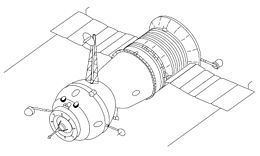Design life Up to 35 days Launched 2 | Applications Manned spacecraft Status Out of service | |
 | ||
Dimensions Height26.04 ft (7.94 m)Volume317.83 cu ft (9.000 m) Manufacturer S. P. Korolev Rocket and Space Corporation Energia Similar Soyuz 7K‑T, Soyuz 7K‑OK, Soyuz 7K‑LOK, Soyuz 7K‑L1 No4L, Kosmos 434 | ||
Soyuz 7K-OKS (also known as Soyuz 7KT-OK) is a version of the Soyuz spacecraft and was the first spacecraft designed for space station flights. Its only manned flights were conducted in 1971, with Soyuz 10 and Soyuz 11.
Contents
Design
The two craft of the Soyuz 7K-OKS generation were modified from the original Soyuz 7K-OK. The new "probe and drogue" docking mechanism, which was first used by these two missions, featured an internal docking hatch that allowed for the first time internal transfer between Soviet spacecraft. This "probe and drogue" docking mechanism introduced with Soyuz 7K-OKS is still in use today at the ISS. The external toroidal fuel tank, a holdover from the original lunar mission models of the Soyuz, was dropped from the 7K-OKS since it was unneeded for Earth orbital flights.
Flights
The Soyuz 7K-OKS flew only twice, Soyuz 10 and Soyuz 11.
On its maiden flight, the 7KT-OK successfully launched into earth orbit, but failed to dock completely with the Salyut 1 space station. Upon reentry, the spacecraft encountered problems with toxic fumes.
This generation of Soyuz spacecraft is notable for the first successful manning of the first space station Salyut 1 by Soyuz 11 – this success was however overshadowed by the death of the crew, who were killed when the capsule depressurized during the re-entry phase.
